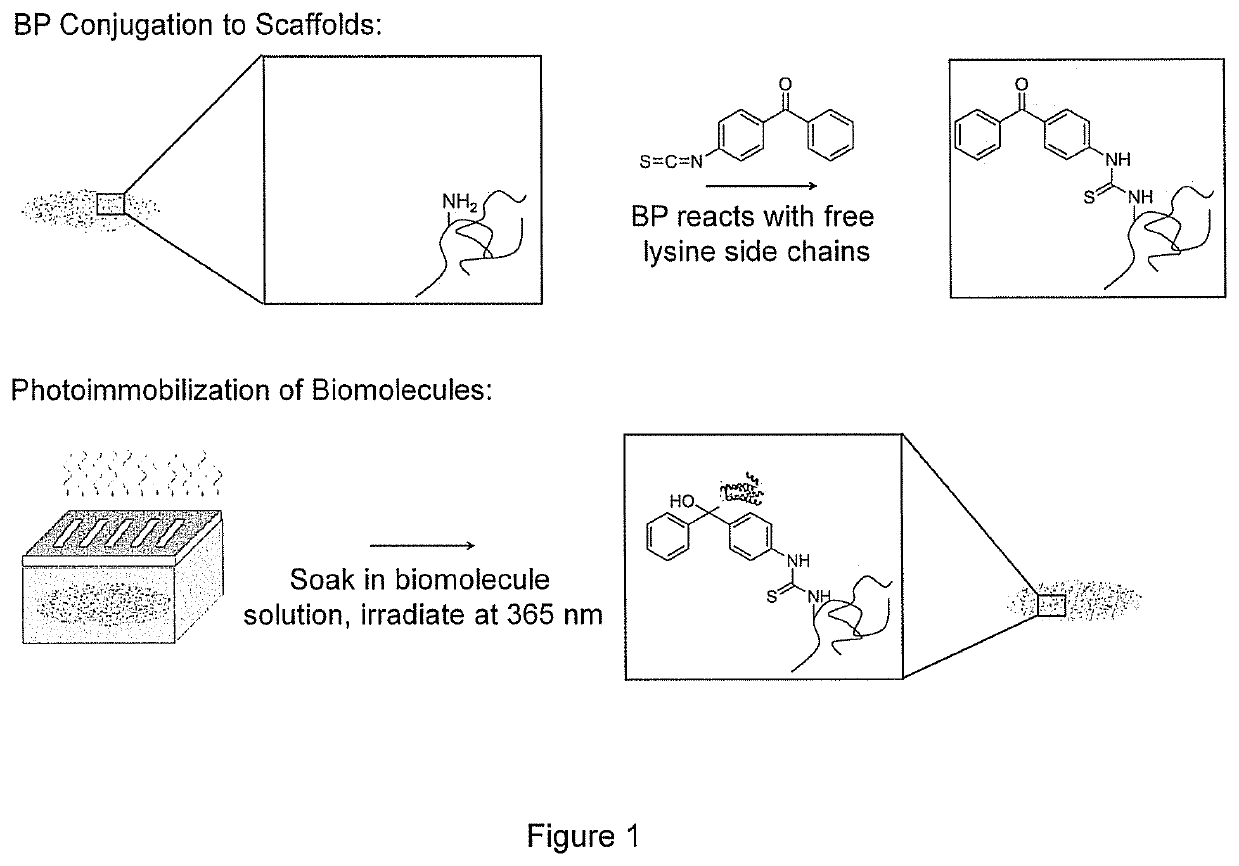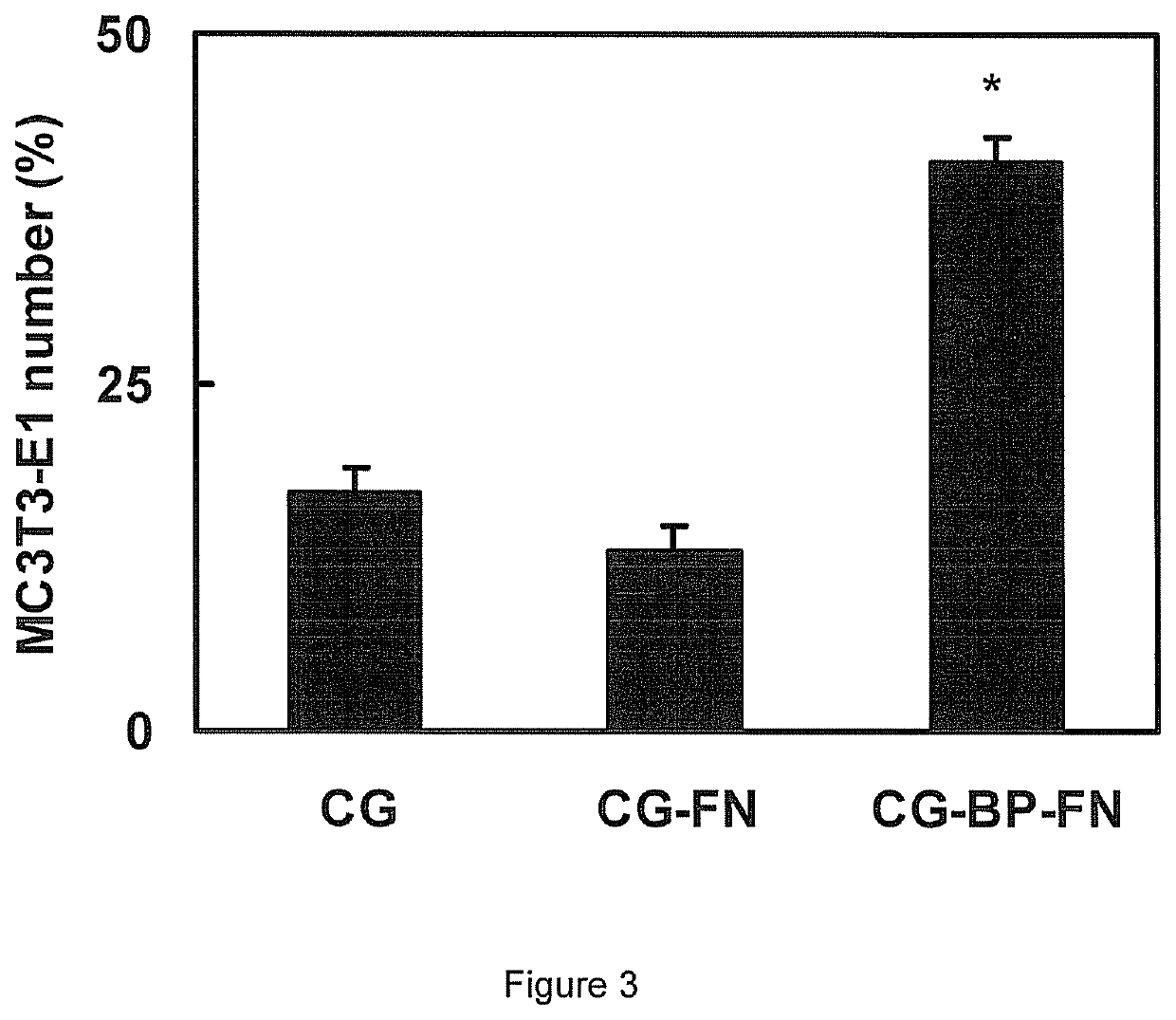Biomolecular patterning of three dimensional tissue scaffolds
a three-dimensional tissue and biomolecular technology, applied in the direction of skeletal/connective tissue cells, prosthesis, peptide/protein ingredients, etc., can solve the problems of inability to easily achieve conformal contact and/or confinement of fluid flow, inability to pattern within porous scaffolds, and inability to conform to fluid flow, etc., to increase the generality of methods, and reduce the potential for adverse effects
- Summary
- Abstract
- Description
- Claims
- Application Information
AI Technical Summary
Benefits of technology
Problems solved by technology
Method used
Image
Examples
example 1
ld Fabrication
[0068]CG scaffolds were fabricated via freeze-drying from a suspension of type I microfibrillar collagen from bovine dermis (Devro Inc., Columbia, S.C.) and chondroitin sulfate derived from shark in 0.05 M acetic acid [25]. This process has been previously optimized to produce a range of CG scaffold variants with a uniform pore microstructure with regular, polyhedral pores [1, 25, 26, 33, 34]. Briefly, a degassed CG suspension was added to an aluminum mold and placed in a freeze dryer (VirTis Genesis, Gardiner, N.Y.) at room temperature. The suspension was cooled at a constant rate (1.0° C. / min) to −4° C. and held there for 2 hrs to allow the suspension temperature to equilibrate; the suspension was then further cooled to a final freezing temperature of −40° C. at 1.0° C. / min, resulting in a continuous, interpenetrating network of ice crystals surrounded by the CG co-precipitate. Ice crystals were removed via sublimation under vacuum (200 mTorr) to produce a highly por...
example 2
Attachment of BP to CG Scaffolds
[0069]A 20 mM solution of benzophenone-4-isothiocyanate containing 0.5 M N,N-diisopropylethylamine was prepared in dimethyl formamide (DMF) via an established method [36]. CG scaffolds were added to the solution and allowed to react at room temperature in the dark for 48 hrs. Scaffolds were thoroughly rinsed three times in DMF, 200 proof ethanol, and water (ELGA LabWater Reservoir, Veolia Water Systems, Buckinghamshire, UK) each for 1 hr; BP-tethered CG scaffolds were then stored under water and in the dark.
example 3
chment of Biomolecules onto BP-Presenting CG Scaffolds
[0070]Biotinylated concanavalin A (ConA-biotin) was purchased from Vector Laboratories (Burlingame, Calif.), fibronectin (FN) was purchased from Invitrogen (Carlsbad, Calif.) and N-Cadherin (NC) was purchased from R&D Systems (Minneapolis, Minn.). Stock solutions of biomolecules were prepared by resuspending the lyophilized proteins in the manufacturer's recommended buffer solutions to a concentration of 1 mg / mL. For ConA-biotin and FN, the buffer was phosphate buffered saline, pH=7.4 (PBS); PBS containing Ca2+ and Mg2+ was used for NC. The solutions were aliquotted and stored at −20° C. Immediately prior to use, the stock solutions were diluted in the respective buffers to yield the empirically determined final solution concentrations of 5 μg / mL ConA-biotin or 100 μg / mL FN.
[0071]BP-modified scaffolds were placed onto a microscope slide and surrounded by a rubber o-ring. A 20 μL aliquot of protein solution was added to the top of...
PUM
| Property | Measurement | Unit |
|---|---|---|
| at a wavelength | aaaaa | aaaaa |
| a wavelength | aaaaa | aaaaa |
| porosity | aaaaa | aaaaa |
Abstract
Description
Claims
Application Information
 Login to View More
Login to View More - R&D
- Intellectual Property
- Life Sciences
- Materials
- Tech Scout
- Unparalleled Data Quality
- Higher Quality Content
- 60% Fewer Hallucinations
Browse by: Latest US Patents, China's latest patents, Technical Efficacy Thesaurus, Application Domain, Technology Topic, Popular Technical Reports.
© 2025 PatSnap. All rights reserved.Legal|Privacy policy|Modern Slavery Act Transparency Statement|Sitemap|About US| Contact US: help@patsnap.com



